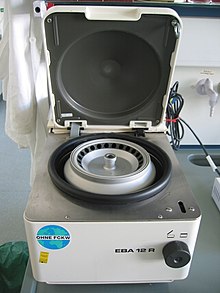
Decantation is a process for the separation of mixtures of immiscible liquids or of a liquid and a solid mixture such as a suspension. The layer closer to the top of the container—the less dense of the two liquids, or the liquid from which the precipitate or sediment has settled out—is poured off, leaving denser liquid or the solid behind. The process typically is unable to remove all of the top layer, meaning the separation is incomplete or at least one of the two separated components is still contaminated by the other one.
Processes

Immiscible liquid separation
Decantation can be used to separate immiscible liquids that have different densities. For example, when a mixture of water and oil is present in a beaker, after some time a distinct layer between the two liquids is formed, with the oil layer floating on top of the water layer. This separation can be done by pouring oil out of the container, leaving water behind. Generally, this technique gives an incomplete separation as it is difficult to pour off all of the top layer without pouring out some parts of the bottom layer.
A separatory funnel is an alternative apparatus for separating liquid layers. It has a valve at the bottom to allow draining off the bottom layer. It can give better separation between the two liquids.
Liquid-solid separation

Decantation can also separate solid and liquid mixtures by allowing gravity to pull the solid fragments to settle at the bottom of the container. In laboratory situations, decantation of mixtures containing solids and liquids occur in test tubes. To enhance productivity, test tubes should be placed at a 45° angle to allow sediments to settle at the bottom of the apparatus.
A centrifuge machine may also be used in decantation as the natural process of settling down is time-consuming and tedious. A centrifuge forces the precipitate to the bottom of the container; if the force is high enough, solids can aggregate to form pellets, making it easier to separate the mixtures. Then the liquid can be more easily poured away, as the precipitate will tend to remain in its compressed form.
A decanter centrifuge may be used for continuous solid-liquid separation.
Examples

Decantation is frequently used to purify a liquid by separating it from a suspension of insoluble particles (e.g. in red wine, where the wine is decanted from the potassium bitartrate crystals to avoid unsavory taste). This makes the wine more tonic and astringent.
Cream accelerates to the top of milk, allowing the separation of milk and cream. This is used in the cheese industry. Fat is determined in butter by decantation.
To obtain a sample of clear water from muddy water, muddy water is poured into another container, which separates the water from the mud.
In the sugar industry, the processing of sugar beets into granular sugar involves many liquid–solid separations; e.g. separation of syrups from crystals.
Decantation is also present in nanotechnology. In the synthesis of high quality silver nanowire (AgNW) solutions and fabrication process of high performance electrodes, decantation is also being applied which greatly simplifies the purification process.
After using a desiccant to absorb water from an organic liquid, the organic liquid can often be decanted away from the desiccant.
The process of deriving vinegar also requires decantation to remove fats and biomolecular antioxidants from the raw substance.
Plasma can be separated from blood through decantation by using a centrifuge.
Mercury is disposed of in water bodies during mining, turning the water unfit and toxic. The mercury can be removed through decantation.
See also
References
- ^ Helmenstine, Todd. "What is decanting?". ThoughtCo. Retrieved 1 March 2018.
- ^ "Separation and purification". Bitesize. BBC.
- ^ Helmenstine, Anne (6 April 2017). "Decantation Definition and Examples". ThoughtCo. Retrieved 1 March 2018.
- Tillisch, H (August 1918). "Decanting". The Journal of Industrial and Engineering Chemistry. 10 (8): 631. doi:10.1021/ie50104a027.
- Goldwyn, Craig (25 May 1988). "The Ritual of Decanting". The Washington Post. Retrieved 1 March 2018.
- ^ Chavez, Oscar. "20 examples of Liquid Decanting". Life persona. Retrieved 22 February 2018.
- Overman and Okimoto, O.R. and Saichi (February 1920). "A Comparison of the Decantation Method with Other Methods for the Determination of Fat in Butter". Journal of Dairy Science. 3 (5): 425–429. doi:10.3168/jds.S0022-0302(20)94286-8. Retrieved 22 February 2018.
- Suhr, Mark R.; Thompson, Phil. "Applications of decanter centrifugals in the beet sugar process" (PDF). Retrieved 23 February 2018.
{{cite journal}}: Cite journal requires|journal=(help) - Mayousse, Céline; Celle, Caroline; Moreau, Eléonore; Mainguet, Jean-François; Carella, Alexandre; Simonato, Jean-Pierre (25 April 2013). "Improvements in purification of silver nanowires by decantation and fabrication of flexible transparent electrodes. Application to capacitive touch sensors" (PDF). Nanotechnology. 24 (21): 215501. Bibcode:2013Nanot..24u5501M. doi:10.1088/0957-4484/24/21/215501. PMID 23619480.
- Nichols, Lisa (29 November 2017). "Decanting". Libretexts. Retrieved 1 March 2018.
- Shih, Lu,Yuan, Chiang and Chia-Hui Lin1, Chih-Hsin; Lu, Chien-Hsing; Yuan, Wei-Li; Chiang, Wei-Ling; Lin, Chia-Hui (March 2011). "Supernatant decanting on a centrifugal platform". Biomicrofluidics. 5 (1): 013414. doi:10.1063/1.3571477. PMC 3082350. PMID 21522503.
{{cite journal}}: CS1 maint: multiple names: authors list (link) CS1 maint: numeric names: authors list (link)
